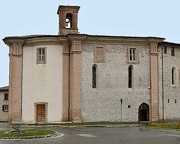


This was originally the site of a Benedictine monastery that was transferred to the Olivetans from San Donato in 1425. These monks moved to the Abbazia di San Pietro in ca. 1505.
In 1519, Pope Leo X, who had just taken over the Duchy of Urbino, moved the poor Clares of the Monastero di Santa Maria del Pellagio to San Benedetto, because he wanted to to build a fortress on the site of their original nunnery. (Bishop Villanus had established this nunnery on a site near the Roman theatre in 1226.)
In 1725, the nuns requested the permission of the episcopal authorities to rebuild their church to a design by Antonio Francesco Berardi di Cagli, insisting that they had considerable funds at their disposal for this project. The project was completed in 1731 and Bishop Sostegno Maria Cavalli consecrated the new church in 1733. The nuns then commissioned a number of works for it from some of the leading artists in Rome, apparently financing this from their own funds.
[Suppression]
The complex now belongs to the Comune di Gubbio, and houses the Laboratorio Multimediale "Gola del Bottaccione".
Church
St Francis receiving the Portiuncula Indulgence (probably 1733)
This altarpiece on the high altar is signed by Sebastiano Conca. It was probably painted in 1733, just before the altar was was consecrated. The altarpiece depicts St Francis’ vision of the Risen Christ and the Virgin in the Cappella del Portiuncula as an angel offers him roses that have miraculously bloomed in winter.
St Benedict (probably 1733)
This small panel above the altarpiece on the high altar is attributed to Gaetano Lapis, who had probably trained under Sebastiano Conca It was probably painted in 1733 (like the altarpiece itself), just before the altar was was consecrated.
Immaculate Virgin (1736)
The inscription on this altarpiece records that Agostino Masucci painted it in Rome in 1736. It depicts the Madonna and Child standing on a cloud, surrounded by putti.
Vision of St Clare (1738)
The inscription on this altarpiece records that Pietro Bianchi painted it in Rome in 1738. It depicts an angel holding the Host appearing to St Clare as she venerates a crucifix.
Ex-Nunnery
The frescoes of the cloister and those in rooms in the ex-nunnery were restored in 2007-9]
Crucifixion (ca. 1460)
This fresco [where ?] is attributed to Giacomo di Benedeto Bedi.
Art from the Complex
Madonna and Child (14th century)
This detached fresco from San Benedetto is now in the Pinacoteca Comunale.
Tree of Jesse (1570)
Sister Settimia degli Accoromboni commissioned this altarpiece, which is attributed to Benedetto Nucci. [Dated by inscription ?] It is now in the Pinacoteca Comunale.
Pala Tondi (1610)
The inscription of this altarpiece in the deposit of the Pinacoteca Comunale records: the artist, Virgilio Nucci; the date, 1610; and the name of the commissioner, Francesco Tondi. The altarpiece, which probably came from the Monastero di San Benedetto, depicts the Madonna and Child enthroned with SS Sebastian, Ubaldus, Francis and Catherine of Alexandria.
Read more:
G. Fidanza, “La Pittura del Settecento a Gubbio.: Storia e Documenti”, (2009) Rome
See in particular Chapter 4, “I Pittori della Chiesa di San benedetto e altri Casi di Pittura Romana della Prima Metà del Secolo”
Return to Nunneries of Gubbio.
Return to Monuments of Gubbio.
Return to Walk II.

